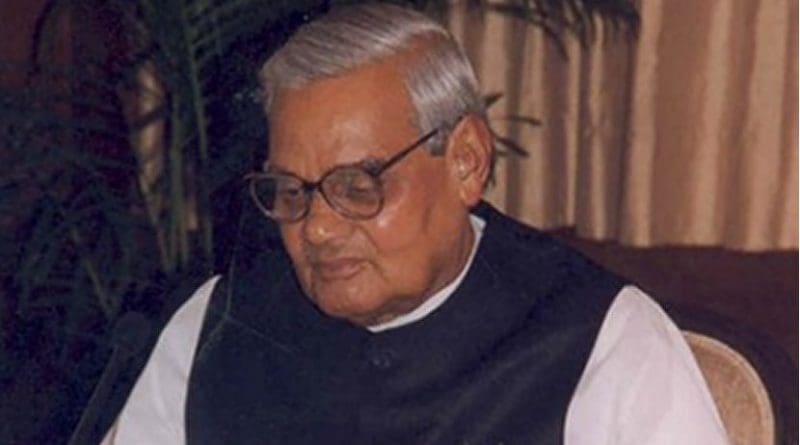India: Contrasting Governance Style Of BJP Prime Ministers – OpEd
Mr. Atal Bihari Vajpayee, the first BJP Prime Minister of India, was in power for around six years. When Mr. Vajpayee passed away at the age of 93. the entire country bowed to him in reverence, applauded his contribution and praised him on several counts. He was essentially hailed for his qualities and attributes such as humaneness, love for all, intellectual capability, oratory skill and being a poet. Certainly, he was loved by all.
The second BJP Prime Minister Mr. Narendra Modi described Mr. Vajpayee as his leader and role model and paid glowing tributes to him with highest level of respect.
However, one cannot but see the significant difference in the style of governance of these two BJP Prime Ministers
As far as the personalities are concerned, Mr. Vajpayee as Prime Minister was considered as soft spoken person with flexible attitude to individuals and events, whereas Mr. Modi is viewed as Prime Minister with inflexible views and uncompromising approach to the various issues based on his convictions. Even while answering the critics, the aggressive approach of Mr. Modi is in sharp contrast to that of Mr. Vajpayee , who managed to mix humour while countering the criticisms leaving no bitterness and often even making his critics enjoy his sarcastic and poetic language.
Such differences in the personality of the two BJP Prime Ministers significantly influenced their governing style, policy formulations and speed of implementation. Whereas Mr. Modi is a workaholic with high level of personal discipline , Mr. Vajpayee was certainly relaxed to some extent in such attributes, perhaps due to his “poetic life style”.
For example, whereas Mr. Modi propagated yoga movement as a means of improving the quality of lives of individuals, Mr. Vajpayee would never have attempted this.
Mr. Vajpayee led the coalition government where BJP did not have the majority of MPs .He led this government comprising of parties with different background and ideologies , with amazing smoothness. In the process, perhaps, Mr. Vajpayee also overlooked several short falls and even misdemeanor of the coalition partners.
On the other hand, Mr. Modi , even though he is leading a coalition government now , has majority of BJP members and is less dependent on the coalition partners for survival of his government. Many people doubt whether Mr. Modi would have been able to lead a coalition government like what Mr. Vajpayee did successfully with BJP not having majority of members.
A few case studies of contrasting style of approach to the issues by Mr. Vajpayee and Mr. Modi can not be missed by any discerning observer.
In 1998, Mr. Vajpayee conducted nuclear explosion which was severely criticized across the world and got India reprimands and sanctions were imposed. Many thought that Mr. Vajpayee took this dramatic step to score a point about India’s nuclear capability without any long term strategy and in the process taking a calculated risk to ignore world reaction. The price India had to pay for this move was high. Perhaps, Mr. Modi would have calculated better ,keeping the long term interests of international relations and would not have attempted this.
The general election was preponed by a few months when Vajpayee was Prime Minister and it was said that he was against this move but bowed to the pressure of the party men. In such situation, perhaps, Mr. Modi would have asserted himself and imposed his view on the party, if he had disagreed with the party’s recommendation.
There is a general perspective that Kandahar episode in 1999 ( when Indian plane was hijacked to Afghanistan by terrorists ) was not handled competently by Vajpayee government. Perhaps, Mr. Modi would not have allowed the hijacked aircraft to leave Chandigarh airport at all and might have confronted the terrorists and tried to call their bluff, with some support from US and western countries . The manner in which Mr. Modi tackled the recent Doklam issue with China clearly reveal his approach to such issues.
In the case of Kashmir , Mr. Vajpayee certainly was able to create confidence in his leadership amongst the people of Kashmir and separatists than what Mr. Modi has been able to do. Mr. Vajpayee’s carrot policy in dealing with Kashmir issue is widely considered better than Mr. Modi’s stick and carrot policy, though both the leaders have not been successful in finding a permanent solution yet.
Mr. Vajpayee’s overall image was as an intellectual and a humanist and friendly / loving person and therefore, any shortfall in his governance was not very much highlighted by the media. In the case of Mr. Modi, his image as an uncompromising person on his basic approach and as strong task master with aggressive approach to governance has created a scenario, where his shortfalls are much more highlighted than several of his achievements by the media.
History will judge the comparative performance of Mr. Vajpayee and Mr. Modi, providing several positive scores to both of them in several aspects. Ultimately, history would also judge that amongst these two great Prime Ministers who have done better for India overall.
It is good that Mr. Modi has declared Mr. Vajpayee as his leader and role model. Mr.Modi has to selectively adopt Mr. Vajpayee’s style of governance, even while steadfastly adhering to the several positives that his government is presently associated with.

